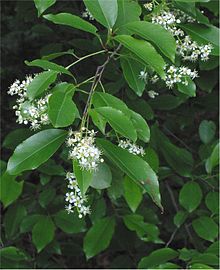Prunus serotina
From Wikipedia, the free encyclopedia
(Redirected from Black cherry)
"Black cherry" redirects here. For other uses, see Black Cherry (disambiguation).

| Prunus serotina | |
|---|---|
| Flowers and leaves | |
| Scientific classification | |
| Kingdom: | Plantae |
| (unranked): | Angiosperms |
| (unranked): | Eudicots |
| (unranked): | Rosids |
| Order: | Rosales |
| Family: | Rosaceae |
| Genus: | Prunus |
| Subgenus: | Padus[1] |
| Species: | P. serotina |
| Binomial name | |
| Prunus serotina Ehrh. | |
 | |
Prunus serotina, commonly called black cherry, wild black cherry, rum cherry, or mountain black cherry, is a woody plant species belonging to the genus Prunus. This cherry is native to eastern North America: from eastern Canada through southern Quebec and Ontario; south through the eastern United States to Texas and central Florida; with disjunct populations in Arizona and New Mexico; and in the mountains of Mexico and Guatemala.[2][3]
Description
The black cherry is a species in the subgenus Padus and is a deciduous tree growing to 15–30 metres (49–98 ft) tall with a trunk diameter of up to 70–120 centimetres (28–47 in), occasionally more, with flowers inracemes. The leaves are simple, 6–14 centimetres (2.4–5.5 in) long, with a serrated margin. The flowers are small (10–15 millimetres (0.39–0.59 in) diameter), with five white petals and about 20 stamens, and are fragrant; there are around 40 flowers on each raceme. The species epithet, serotina, means "late,"[4] and refers to the tree flowering later in the season than many other cherry species. The fruit is a drupe, 1 centimetre (0.39 in) in diameter, green to red at first, ripening to black; it is usually astringent and bitter when eaten fresh, but also somewhat sweet. The fruit is readily eaten by birds.[2][5]
A mature black cherry can easily be identified in a forest by its very broken, dark grey to black bark, which has the appearance of very thick, burnt cornflakes (an easy way to remember this is burnt cornflakes = black cherry). However, for about the first decade or so of its life, the bark resembles that of a birch, and is thin and striped. It can also quickly be identified by its long, shiny leaves resembling those of a sourwood, and by an almond-like odor when a young twig is scratched and held close to the nose.[6][7]
[edit]Subspecies
The two subspecies of Prunus serotina:[8]
- P. s. subsp. serotina - Canada, United States
- P. s. subsp. capuli (Cav.) McVaugh — Mexico, Guatemala
The typical subsp. P. s. serotina is sometimes further divided into four varieties, var. serotina in the east of the range, var. eximia in Texas, and vars. rufula and virens in Arizona, New Mexico and Texas.[3]
Black cherry is closely related to the chokecherry (Prunus virginiana); chokecherry, however, is classified as a shrub or small tree and has smaller, less glossy leaves.
[edit]Ecology and cultivation
P. serotina is a pioneer species. In the Midwest, it is seen growing mostly in old fields with other sunlight-loving species, such as black walnut, black locust, and hackberry. Gleason and Cronquist (1991) describe P. serotina as "[f]ormerly a forest tree, now abundant as a weed-tree of roadsides, waste land, and forest-margins."[9] It is a moderately long-lived tree, with ages of up to 258 years known, though it is prone to storm damage, with branches breaking easily; any decay resulting, however, only progresses slowly.[2]
P. serotina is also a host of caterpillars of various Lepidoptera (see List of Lepidoptera which feed on Prunus). The eastern tent caterpillar defoliates entire groves some springs.
P. serotina was widely introduced into Western and Central Europe as an ornamental tree[10] in the mid 20th century,[11][12] where it has become locally naturalized.[10] It has acted as an invasive species there, negatively affecting forest community biodiversity and regeneration.[13]
[edit]Biochemistry
Like apricots, the seeds of black cherries contain compounds that can be converted into cyanide, such as amygdalin.[14][15] These compounds releasehydrogen cyanide when the seed is ground or minced, which releases enzymes that break down the compounds. These enzymes include amygdalin beta-glucosidase, prunasin beta-glucosidase and mandelonitrile lyase.[16] In contrast, although the flesh of cherries also contain these compounds, they do not contain the enzymes needed to produce cyanide, so the flesh is safe to eat.[17]
The foliage, particularly when wilted, contains cyanogenic glycosides, which convert to hydrogen cyanide if eaten by animals.[5] Farmers are recommended to remove any trees that fall in a field containing livestock, because the wilted leaves could poison the animals. Removal is not always practical, though, because they often grow in very large numbers on farms, taking advantage of the light brought about by mowing and grazing. Entire fencerows can be lined with this poisonous tree, making it difficult to monitor all the branches falling into the grazing area. Black cherry is a leading cause of livestock illness, and grazing animals' access to it should be limited.
[edit]Uses
The fruit of Prunus serotina is suitable for making jam and cherry pies, and has some use in flavoring liqueurs; they are also a popular flavoring for sodas and ice creams. The black cherry is commonly used instead of sweet cherries (Prunus avium) to achieve a sharper taste. It is also used in cakes which include dark chocolate, such as a Black Forest gateau and as garnishes forcocktails.[citation needed]
The wood of P. serotina is also used for cooking and smoking foods, where it imparts a unique flavor.
P. serotina timber is valuable; perhaps the premier cabinetry timber of the U.S., traded as "cherry". It is known for its strong red color and high price. Its density when dried is around 580 kg/m3(980 lb/cu yd).[18]
P. serotina trees are sometimes planted ornamentally.


No comments:
Post a Comment